trailer KIA CARENS RHD 2018 Owners Manual
[x] Cancel search | Manufacturer: KIA, Model Year: 2018, Model line: CARENS RHD, Model: KIA CARENS RHD 2018Pages: 723, PDF Size: 40.94 MB
Page 10 of 723
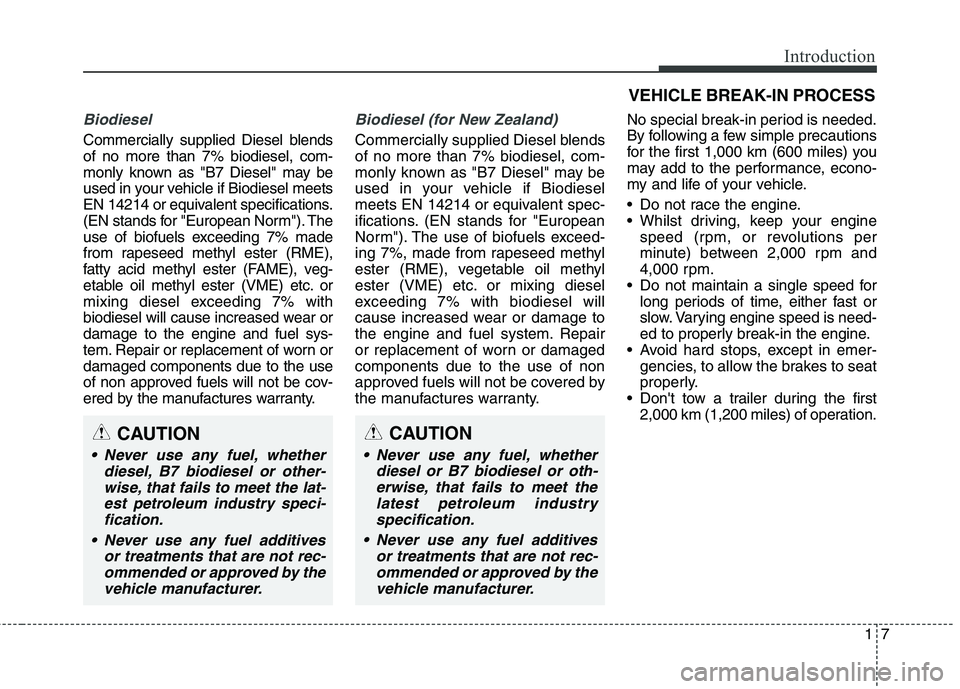
17
Introduction
Biodiesel
Commercially supplied Diesel blends of no more than 7% biodiesel, com-
monly known as "B7 Diesel" may be
used in your vehicle if Biodiesel meets
EN 14214 or equivalent specifications.
(EN stands for "European Norm"). The
use of biofuels exceeding 7% made
from rapeseed methyl ester (RME),
fatty acid methyl ester (FAME), veg-
etable oil methyl ester (VME) etc. or
mixing diesel exceeding 7% with
biodiesel will cause increased wear ordamage to the engine and fuel sys-
tem. Repair or replacement of worn ordamaged components due to the use
of non approved fuels will not be cov-
ered by the manufactures warranty.
Biodiesel (for New Zealand)
Commercially supplied Diesel blends of no more than 7% biodiesel, com-
monly known as "B7 Diesel" may be
used in your vehicle if Biodiesel
meets EN 14214 or equivalent spec-
ifications. (EN stands for "European
Norm"). The use of biofuels exceed-
ing 7%, made from rapeseed methyl
ester (RME), vegetable oil methyl
ester (VME) etc. or mixing diesel
exceeding 7% with biodiesel will
cause increased wear or damage to
the engine and fuel system. Repair
or replacement of worn or damagedcomponents due to the use of non
approved fuels will not be covered by
the manufactures warranty.No special break-in period is needed.
By following a few simple precautions
for the first 1,000 km (600 miles) you
may add to the performance, econo-
my and life of your vehicle.
Do not race the engine.
Whilst driving, keep your engine
speed (rpm, or revolutions per
minute) between 2,000 rpm and
4,000 rpm.
Do not maintain a single speed for long periods of time, either fast or
slow. Varying engine speed is need-
ed to properly break-in the engine.
Avoid hard stops, except in emer- gencies, to allow the brakes to seat
properly.
Don't tow a trailer during the first 2,000 km (1,200 miles) of operation.
CAUTION
Never use any fuel, whether
diesel, B7 biodiesel or other-wise, that fails to meet the lat-est petroleum industry speci-fication.
Never use any fuel additives or treatments that are not rec-ommended or approved by thevehicle manufacturer.
CAUTION
Never use any fuel, whether diesel or B7 biodiesel or oth-erwise, that fails to meet the latest petroleum industryspecification.
Never use any fuel additives or treatments that are not rec-ommended or approved by the vehicle manufacturer.
VEHICLE BREAK-IN PROCESS
Page 193 of 723
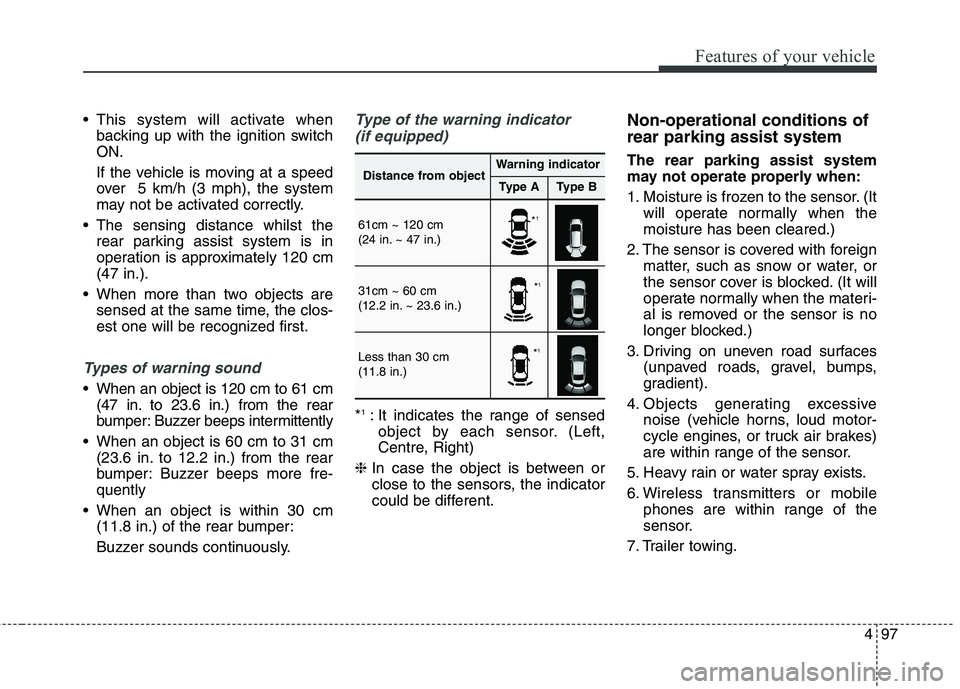
497
Features of your vehicle
This system will activate whenbacking up with the ignition switch ON.
If the vehicle is moving at a speed
over 5 km/h (3 mph), the system
may not be activated correctly.
The sensing distance whilst the rear parking assist system is in
operation is approximately 120 cm(47 in.).
When more than two objects are sensed at the same time, the clos-
est one will be recognized first.
Types of warning sound
When an object is 120 cm to 61 cm(47 in. to 23.6 in.) from the rear
bumper: Buzzer beeps intermittently
When an object is 60 cm to 31 cm (23.6 in. to 12.2 in.) from the rear
bumper: Buzzer beeps more fre-quently
When an object is within 30 cm (11.8 in.) of the rear bumper:
Buzzer sounds continuously.
Type of the warning indicator
(if equipped)
* 1
: It indicates the range of sensed
object by each sensor. (Left,
Centre, Right)
❈ In case the object is between or
close to the sensors, the indicator
could be different. Non-operational conditions of rear parking assist system The rear parking assist system
may not operate properly when:
1. Moisture is frozen to the sensor. (It
will operate normally when the moisture has been cleared.)
2. The sensor is covered with foreign matter, such as snow or water, or
the sensor cover is blocked. (It will
operate normally when the materi-
al is removed or the sensor is no
longer blocked.)
3. Driving on uneven road surfaces (unpaved roads, gravel, bumps,
gradient).
4. Objects generating excessive noise (vehicle horns, loud motor-
cycle engines, or truck air brakes)
are within range of the sensor.
5. Heavy rain or water spray exists.
6. Wireless transmitters or mobile phones are within range of the
sensor.
7. Trailer towing.
Distance from objectWarning indicator
Type AType B
61cm ~ 120 cm
(24 in. ~ 47 in.)
31cm ~ 60 cm
(12.2 in. ~ 23.6 in.)
Less than 30 cm (11.8 in.)
* 1
* 1
* 1
Page 203 of 723

4107
Features of your vehicle
Operating condition
The system will help park the vehicle
in the middle or back of a parked
vehicle. Use the system when all the
below conditions are met.
When the parking space is astraight line
When parallel parking is required
When there is a parked vehicle
When there is enough space to move the vehicle Non-operating condition
Never use the Smart Parking Assist
System in the below conditions.
Curved parking space
Inclined roads
A vehicle loaded with longer or
wider cargo compared to the vehicle
Diagonal parking space
Parking space with trash, grass or barriers
Heavy snow or rain
A pole close to the parking line
Bumpy roads
A vehicle equipped with a snow chain or spare tyre
Tyre pressure lower or higher than the standard tyre pressure
A trailer connected to the vehicle
Slippery or uneven road
Big vehicles such as buses or trucks parked
Sensor covered with foreign mat- ter, such as snow or water
Moisture frozen on the sensor
A motorcycle or bicycle parked
OVF041307R
■ Right side
- parallel mode■ Left side
-parallel mode(Continued)
Kia recommends to always
use the same size tyre and
wheel recommended by an
authorised Kia dealer/ service
partner. If you use a different
tyre or wheel size the system
may not work properly.
If you use a different tyre or
wheel size rather than the size
recommended by an autho-
rised Kia dealer/service part-
ner, the system may not work
properly. Always use the same
size tyre and wheel.
If you use additional frame on license plate then SPAS may
generate abnormal warningsound.
Page 437 of 723
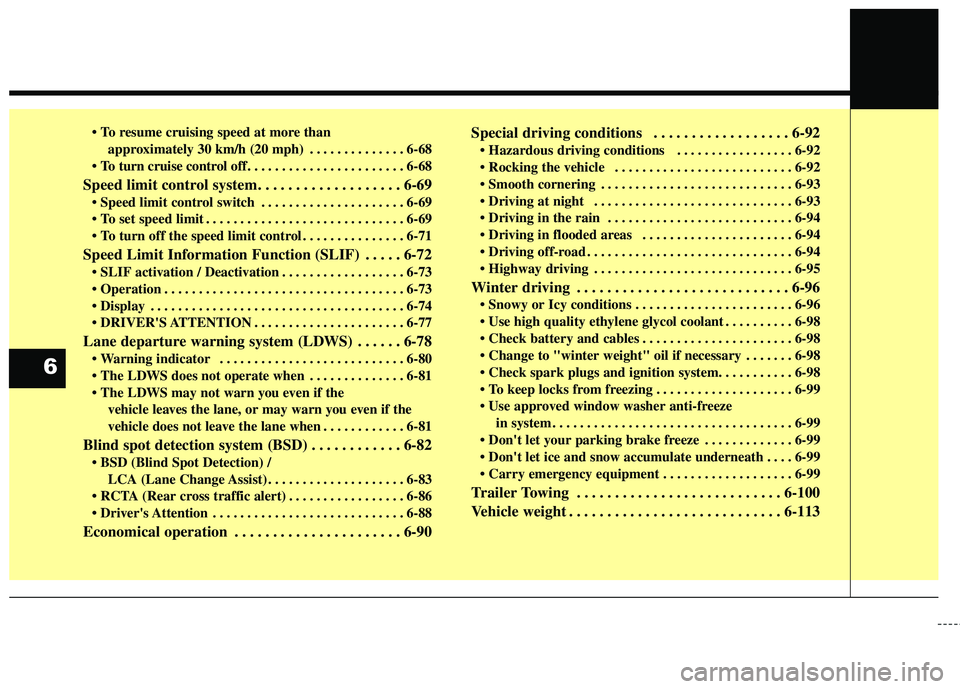
approximately 30 km/h (20 mph) . . . . . . . . . . . . . . 6-68
. . . . . . . . . . . . . . . . . . . . . . . 6-68
Speed limit control system. . . . . . . . . . . . . . . . . . . 6-69 . . . . . . . . . . . . . . . . . . . . . 6-69
. . . . . . . . . . . . . . . . . . . . . . . . . . . . . 6-69
. . . . . . . . . . . . . . . 6-71
Speed Limit Information Function (SLIF) . . . . . 6-72 . . . . . . . . . . . . . . . . . . 6-73
. . . . . . . . . . . . . . . . . . . . . . . . . . . . . . . . . . . 6-73
. . . . . . . . . . . . . . . . . . . . . . . . . . . . . . . . . . . . . 6-74
. . . . . . . . . . . . . . . . . . . . . . 6-77
Lane departure warning system (LDWS) . . . . . . 6-78 . . . . . . . . . . . . . . . . . . . . . . . . . . . 6-80
. . . . . . . . . . . . . . 6-81
vehicle leaves the lane, or may warn you even if the
vehicle does not leave the lane when . . . . . . . . . . . . 6-81
Blind spot detection system (BSD) . . . . . . . . . . . . 6-82 LCA (Lane Change Assist) . . . . . . . . . . . . . . . . . . . . 6-83
. . . . . . . . . . . . . . . . . 6-86
. . . . . . . . . . . . . . . . . . . . . . . . . . . . 6-88
Economical operation . . . . . . . . . . . . . . . . . . . . . . 6-90 Special driving conditions . . . . . . . . . . . . . . . . . . 6-92
. . . . . . . . . . . . . . . . . 6-92
. . . . . . . . . . . . . . . . . . . . . . . . . . 6-92
. . . . . . . . . . . . . . . . . . . . . . . . . . . . 6-93
. . . . . . . . . . . . . . . . . . . . . . . . . . . . . 6-93
. . . . . . . . . . . . . . . . . . . . . . 6-94
. . . . . . . . . . . . . . . . . . . . . . . . . . . . . . 6-94
. . . . . . . . . . . . . . . . . . . . . . . . . . . . . 6-95
Winter driving . . . . . . . . . . . . . . . . . . . . . . . . . . . . 6-96 . . . . . . . . . . . . . . . . . . . . . . . 6-96
. . . . . . . . . . 6-98
. . . . . . . . . . . . . . . . . . . . . . 6-98
. . . . . . . 6-98
. . . . . . . . . . . . . . . . . . . . 6-99
in system . . . . . . . . . . . . . . . . . . . . . . . . . . . . . . . . . . . 6-99
. . . . . . . . . . . . . 6-99
. . . . 6-99
. . . . . . . . . . . . . . . . . . . 6-99
Trailer Towing . . . . . . . . . . . . . . . . . . . . . . . . . . . 6-100
Vehicle weight . . . . . . . . . . . . . . . . . . . . . . . . . . . . 6-113
6
Page 483 of 723
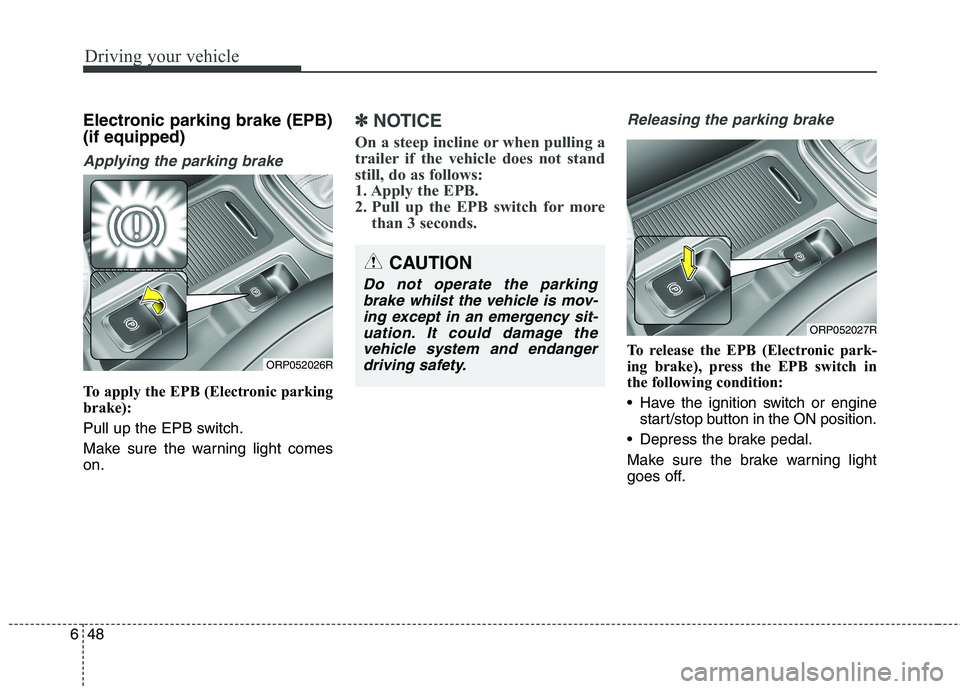
Driving your vehicle
48
6
Electronic parking brake (EPB) (if equipped)
Applying the parking brake
To apply the EPB (Electronic parking
brake):
Pull up the EPB switch.
Make sure the warning light comes on.
✽✽
NOTICE
On a steep incline or when pulling a
trailer if the vehicle does not stand
still, do as follows:
1. Apply the EPB.
2. Pull up the EPB switch for more than 3 seconds. Releasing the parking brake
To release the EPB (Electronic park-
ing brake), press the EPB switch in
the following condition:
Have the ignition switch or enginestart/stop button in the ON position.
Depress the brake pedal.
Make sure the brake warning light
goes off.ORP052026R
CAUTION
Do not operate the parking brake whilst the vehicle is mov-ing except in an emergency sit- uation. It could damage thevehicle system and endangerdriving safety.
ORP052027R
Page 484 of 723
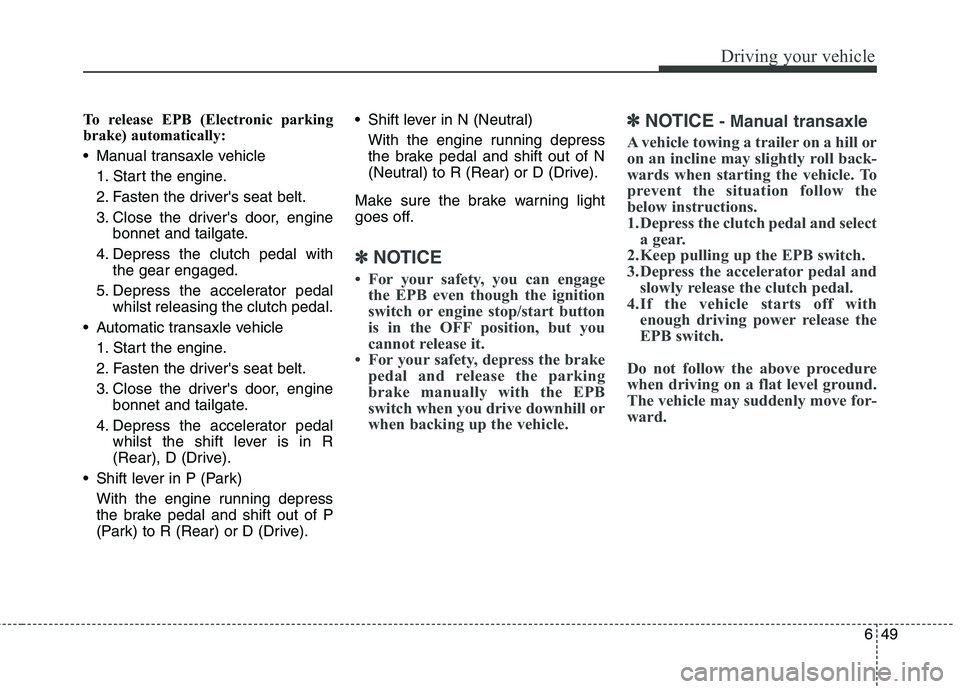
649
Driving your vehicle
To release EPB (Electronic parking
brake) automatically:
Manual transaxle vehicle1. Start the engine.
2. Fasten the driver's seat belt.
3. Close the driver's door, engine bonnet and tailgate.
4. Depress the clutch pedal with the gear engaged.
5. Depress the accelerator pedal whilst releasing the clutch pedal.
Automatic transaxle vehicle
1. Start the engine.
2. Fasten the driver's seat belt.
3. Close the driver's door, engine bonnet and tailgate.
4. Depress the accelerator pedal whilst the shift lever is in R
(Rear), D (Drive).
Shift lever in P (Park) With the engine running depress
the brake pedal and shift out of P
(Park) to R (Rear) or D (Drive). Shift lever in N (Neutral)
With the engine running depress
the brake pedal and shift out of N
(Neutral) to R (Rear) or D (Drive).
Make sure the brake warning light
goes off.
✽✽ NOTICE
For your safety, you can engage the EPB even though the ignition
switch or engine stop/start button
is in the OFF position, but you
cannot release it.
For your safety, depress the brake pedal and release the parking
brake manually with the EPB
switch when you drive downhill or
when backing up the vehicle. ✽
✽
NOTICE - Manual transaxle
A vehicle towing a trailer on a hill or
on an incline may slightly roll back-
wards when starting the vehicle. To
prevent the situation follow the
below instructions.
1. Depress the clutch pedal and select a gear.
2. Keep pulling up the EPB switch.
3. Depress the accelerator pedal and slowly release the clutch pedal.
4.If the vehicle starts off with enough driving power release the
EPB switch.
Do not follow the above procedure
when driving on a flat level ground.
The vehicle may suddenly move for-
ward.
Page 520 of 723
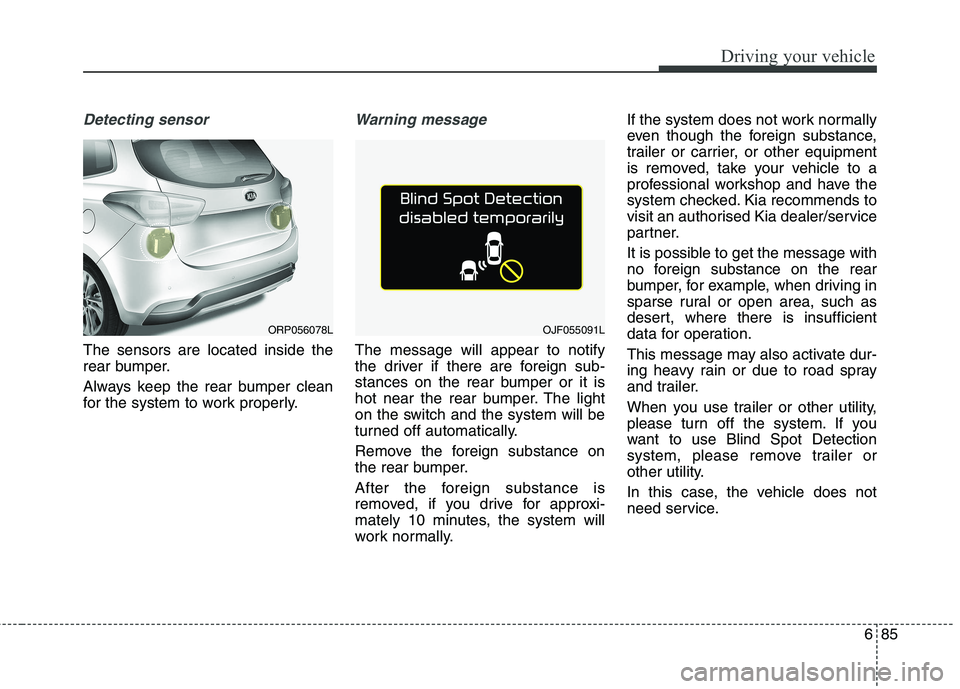
685
Driving your vehicle
Detecting sensor
The sensors are located inside the
rear bumper.
Always keep the rear bumper clean
for the system to work properly.
Warning message
The message will appear to notify
the driver if there are foreign sub-
stances on the rear bumper or it is
hot near the rear bumper. The light
on the switch and the system will be
turned off automatically.
Remove the foreign substance on
the rear bumper.
After the foreign substance is
removed, if you drive for approxi-
mately 10 minutes, the system will
work normally.If the system does not work normally
even though the foreign substance,
trailer or carrier, or other equipment
is removed, take your vehicle to a
professional workshop and have the
system checked. Kia recommends to
visit an authorised Kia dealer/service
partner.
It is possible to get the message with
no foreign substance on the rear
bumper, for example, when driving in
sparse rural or open area, such as
desert, where there is insufficient
data for operation.
This message may also activate dur-
ing heavy rain or due to road spray
and trailer.
When you use trailer or other utility,
please turn off the system. If you
want to use Blind Spot Detection
system, please remove trailer or
other utility.
In this case, the vehicle does not
need service.
OJF055091LORP056078L
Page 524 of 723

689
Driving your vehicle
(Continued)
- There is a fixed object near thevehicle, such as a pedestrian,
animal, guardrail and tunnel.
- If there are metal component on the road or near the road unusu-
ally. (For example, subway con-struction area)
- A big vehicle is near such as a bus or truck.
- A motorcycle or bicycle is near.
- A flat trailer is near.
- If the vehicle has started at the same time as the vehicle next to
you and has accelerated.
- When the other vehicle passes at a very fast speed.
- Whilst changing lanes.
- When going down or up a steep, uneven road.
- When the other vehicle approaches very close.
- When a trailer or carrier is installed.
(Continued)(Continued)
- When the temperature of the
rear bumper is very high or low.
- When the sensors are blocked by other vehicles, walls or park-
ing-lot pillars.
- When the detected vehicle also moves back, as your vehicle
drives back.
- If there are small things like pedestrian, shopping cart and
baby carriage.
- If there is low height vehicle like sport vehicle.
- When other vehicles are close to your vehicle.
- When the vehicle in the next lane moves two lanes away from
you OR when the vehicle two
lanes away moves to the next
lane from you.
- When driving through a narrow road with many plants.
- When driving on wet surface.
Page 535 of 723
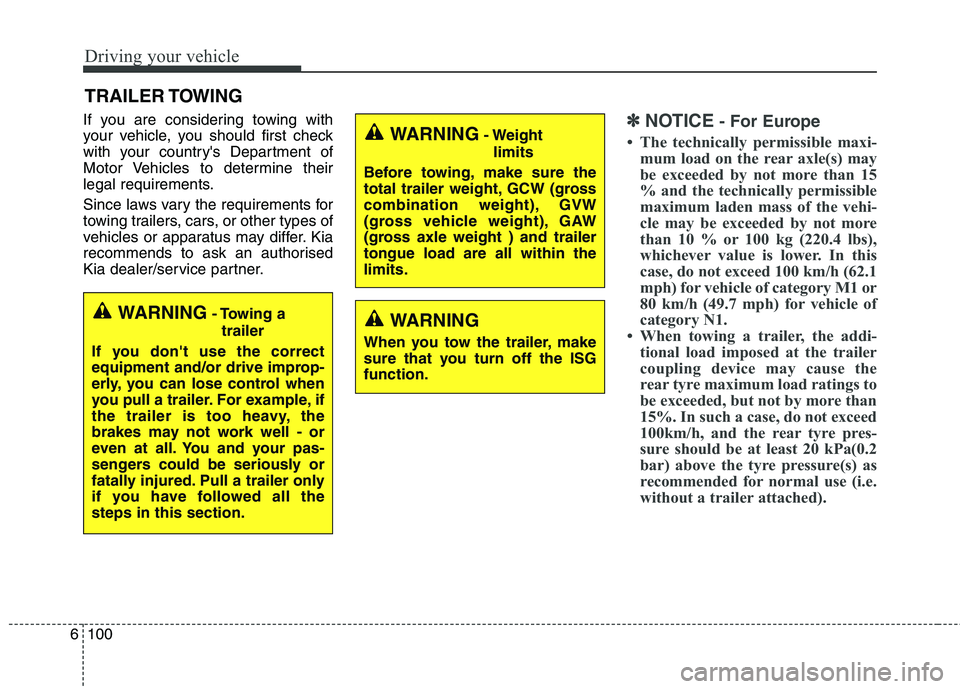
Driving your vehicle
100
6
If you are considering towing with
your vehicle, you should first check
with your country's Department of
Motor Vehicles to determine their
legal requirements.
Since laws vary the requirements for
towing trailers, cars, or other types of
vehicles or apparatus may differ. Kia
recommends to ask an authorised
Kia dealer/service partner.✽✽
NOTICE - For Europe
The technically permissible maxi- mum load on the rear axle(s) may
be exceeded by not more than 15
% and the technically permissible
maximum laden mass of the vehi-
cle may be exceeded by not more
than 10 % or 100 kg (220.4 lbs),
whichever value is lower. In this
case, do not exceed 100 km/h (62.1
mph) for vehicle of category M1 or
80 km/h (49.7 mph) for vehicle of
category N1.
When towing a trailer, the addi- tional load imposed at the trailer
coupling device may cause the
rear tyre maximum load ratings to
be exceeded, but not by more than
15%. In such a case, do not exceed
100km/h, and the rear tyre pres-
sure should be at least 20 kPa(0.2
bar) above the tyre pressure(s) as
recommended for normal use (i.e.
without a trailer attached).
TRAILER TOWING
WARNING - Towing a
trailer
If you don't use the correct
equipment and/or drive improp-
erly, you can lose control when
you pull a trailer. For example, if
the trailer is too heavy, the
brakes may not work well - or
even at all. You and your pas-
sengers could be seriously or
fatally injured. Pull a trailer only
if you have followed all thesteps in this section.
WARNING - Weight
limits
Before towing, make sure the
total trailer weight, GCW (gross
combination weight), GVW
(gross vehicle weight), GAW
(gross axle weight ) and trailertongue load are all within thelimits.
WARNING
When you tow the trailer, make
sure that you turn off the ISGfunction.
Page 536 of 723
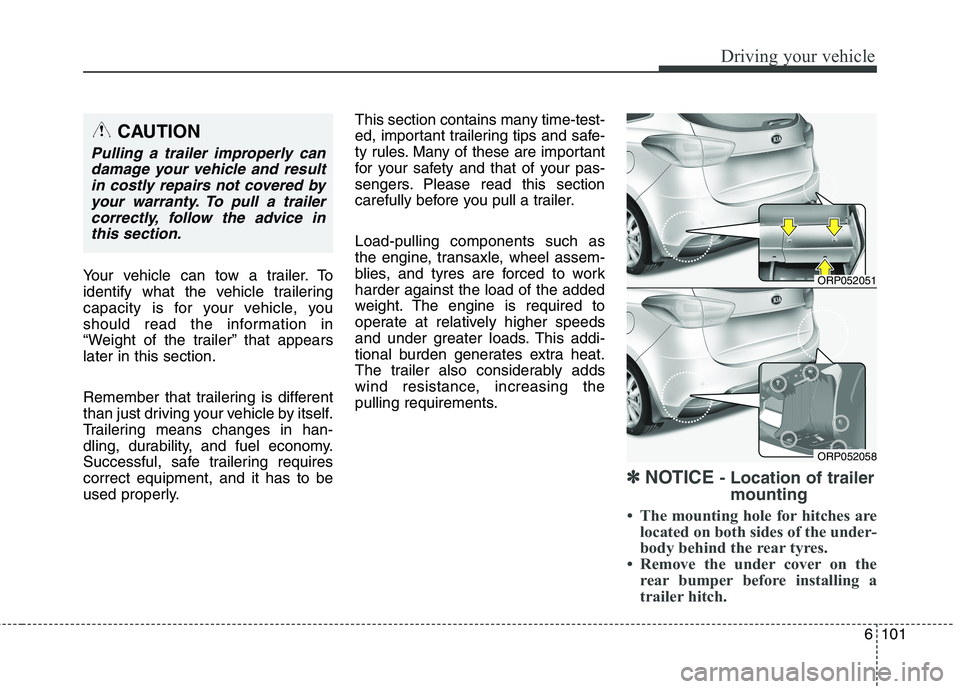
6101
Driving your vehicle
Your vehicle can tow a trailer. To
identify what the vehicle trailering
capacity is for your vehicle, you
should read the information in
“Weight of the trailer” that appearslater in this section.
Remember that trailering is different
than just driving your vehicle by itself.
Trailering means changes in han-
dling, durability, and fuel economy.
Successful, safe trailering requirescorrect equipment, and it has to be
used properly.This section contains many time-test-
ed, important trailering tips and safe-
ty rules. Many of these are important
for your safety and that of your pas-
sengers. Please read this section
carefully before you pull a trailer. Load-pulling components such as
the engine, transaxle, wheel assem-
blies, and tyres are forced to workharder against the load of the added
weight. The engine is required to
operate at relatively higher speeds
and under greater loads. This addi-
tional burden generates extra heat.
The trailer also considerably adds
wind resistance, increasing the
pulling requirements.
✽✽
NOTICE - Location of trailer
mounting
The mounting hole for hitches are located on both sides of the under-
body behind the rear tyres.
Remove the under cover on the rear bumper before installing a
trailer hitch.
CAUTION
Pulling a trailer improperly can
damage your vehicle and resultin costly repairs not covered by your warranty. To pull a trailercorrectly, follow the advice inthis section.
ORP052051
ORP052058